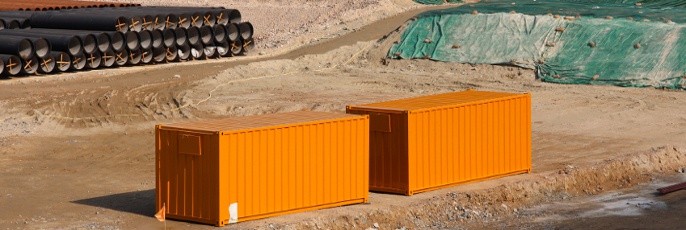

Every year thousands of used shipping containers are retired across the country and become available as an alternative option for storing items at your home or business. Nearly all used shipping containers remain wind and watertight and their steel construction means they can last for decades. Industry professionals call this 'over built' as the containers are designed for the high seas and storage of inventory and equipment on a job site is simply no match for the steel shipping containers. Standard shipping container sizes are 10 foot (can fit a small garage or small construction equipment), 20 foot (can fit a 2-3 rooms of furniture or a car), 40 foot (can hold a typical household of goods and the inventory of a typical retail shop), although customizations in both length and features is available in nearly every city. While no option is 100% secure, the steel build of used shipping containers is ideal for companies who need to lock up expensive equipment outdoors.
Will the shipping container have the old worn paint and logo of the shipper?
Only containers sold 'as-is' will have rust, old logos and worn paint. Nearly all shipping containers sold by Equipment Base partners have neutral paint, any and all rust scrubbed off, watertight seals and fully functioning doors will be intact.
How much does a used shipping container cost?
For WWT (wind & watertight), fully functional used shipping containers you can expect to pay from $1,800-$3,000 for 20 foot and from $2,800-$4,000 for a 40 foot. However, we stress that inventory levels fluctuate and prices can jump quite a bit if inventory is scarce. Steel prices can also have a large impact on the cost of a container year to year. So if you paid $3,000 for a used 40 foot shipping container two years ago, do not expect to be able to get the same deal today.
What kind of customizations are available?
The most popular customizations include windows, steel bars over windows, roll up doors vs. swing out doors, addition of doors to both ends, doors on the side of a container (side doors make it easy to load inventory with a forklift or other machinery), ventilation and shelving. Nearly any kind of shipping container customization is possible major port cities will have access to more skilled welders and craftsmen.
Where can I go to stay on top of industry developments?
We recommend looking to port authorities for details on fluctuations in shipping container availability, pricing swings and more. The American Association of Port Authorities (AAPA) has well manicured and up to date info, and you can also check out www.seaportsdeliverprosperity.org for overall industry perspective.